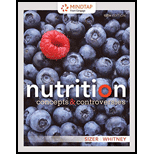
NUTRITION-MINDTAP (1 TERM)
15th Edition
ISBN: 9781337907101
Author: Sizer
Publisher: CENGAGE L
expand_more
expand_more
format_list_bulleted
Concept explainers
Question
Chapter 11, Problem 11SC
Summary Introduction
To determine:
Whether the statement ‘diabetes is a major risk factor for CVD’ is correct or not.
Introduction:
Diabetes is a condition in which the blood glucose level rises due to decrease in the insulin function. Due to the increased in the blood sugar, the excretory system excretes more glucose in the excretory products.
Expert Solution & Answer
Want to see the full answer?
Check out a sample textbook solution
Chapter 11 Solutions
NUTRITION-MINDTAP (1 TERM)
Ch. 11 - Complementary and alternative medicines (CAM)...Ch. 11 - Prob. 2RQCh. 11 - Prob. 3RQCh. 11 - Prob. 1SCCh. 11 - Prob. 2SCCh. 11 - Prob. 3SCCh. 11 - Prob. 4SCCh. 11 - Men suffer more often from heart attacks than...Ch. 11 - Smoking powerfully raises the risk for CVD in men...Ch. 11 - Which of the following minerals may help to...
Knowledge Booster
Learn more about
Need a deep-dive on the concept behind this application? Look no further. Learn more about this topic, health-nutrition and related others by exploring similar questions and additional content below.Similar questions
- During the absorptive state, glucose levels are ________, insulin levels are ________, and glucagon levels ________. a. high; low; stay the same b. low; low; stay the same c. high; high; are high d. high; high; are lowarrow_forwardAthletes may take synthetic EPO to boost their ________. blood calcium levels secretion of growth hormone blood oxygen levels muscle massarrow_forwardWhich of the following statements about insulin is true? Insulin acts as a transport protein, cany in g glucose across the cell membrane. Insulin facilitates the movement of inti acellular glucose transporters to the cell membrane. Insulin stimulates the breakdown of stored glycogen into glucose. Insulin stimulates the kidneys to reabsorb glucose into the bloodstream.arrow_forward
Recommended textbooks for you
 NutritionHealth & NutritionISBN:9781337906371Author:Sizer, Frances Sienkiewicz., WHITNEY, ElliePublisher:Cengage Learning,
NutritionHealth & NutritionISBN:9781337906371Author:Sizer, Frances Sienkiewicz., WHITNEY, ElliePublisher:Cengage Learning, Nutrition Through The Life CycleHealth & NutritionISBN:9781337919333Author:Brown, Judith E.Publisher:Cengage Learning,Health Safety And Nutrition F/Young ChildHealth & NutritionISBN:9781305144767Author:MAROTZPublisher:Cengage
Nutrition Through The Life CycleHealth & NutritionISBN:9781337919333Author:Brown, Judith E.Publisher:Cengage Learning,Health Safety And Nutrition F/Young ChildHealth & NutritionISBN:9781305144767Author:MAROTZPublisher:Cengage

Nutrition
Health & Nutrition
ISBN:9781337906371
Author:Sizer, Frances Sienkiewicz., WHITNEY, Ellie
Publisher:Cengage Learning,

Nutrition Through The Life Cycle
Health & Nutrition
ISBN:9781337919333
Author:Brown, Judith E.
Publisher:Cengage Learning,

Health Safety And Nutrition F/Young Child
Health & Nutrition
ISBN:9781305144767
Author:MAROTZ
Publisher:Cengage


